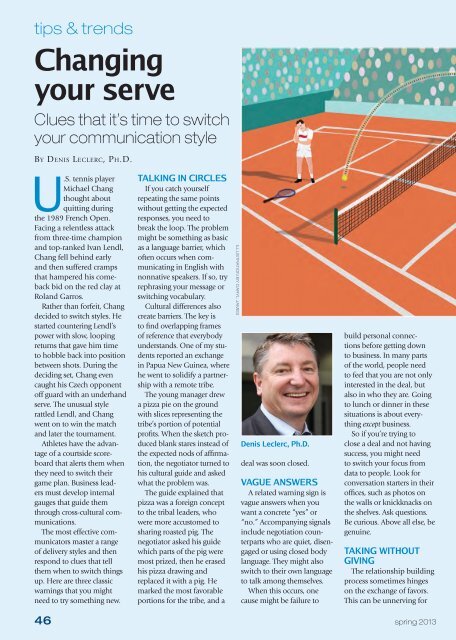Current Issue - Thunderbird Magazine - Thunderbird School of ...
Current Issue - Thunderbird Magazine - Thunderbird School of ...
Current Issue - Thunderbird Magazine - Thunderbird School of ...
Create successful ePaper yourself
Turn your PDF publications into a flip-book with our unique Google optimized e-Paper software.
tips & trends<br />
Changing<br />
your serve<br />
Clues that it’s time to switch<br />
your communication style<br />
BY DENIS LECLERC, PH.D.<br />
U.S. tennis player<br />
Michael Chang<br />
thought about<br />
quitting during<br />
the 1989 French Open.<br />
Facing a relentless attack<br />
from three-time champion<br />
and top-ranked Ivan Lendl,<br />
Chang fell behind early<br />
and then suffered cramps<br />
that hampered his comeback<br />
bid on the red clay at<br />
Roland Garros.<br />
Rather than forfeit, Chang<br />
decided to switch styles. He<br />
started countering Lendl’s<br />
power with slow, looping<br />
returns that gave him time<br />
to hobble back into position<br />
between shots. During the<br />
deciding set, Chang even<br />
caught his Czech opponent<br />
<strong>of</strong>f guard with an underhand<br />
serve. The unusual style<br />
rattled Lendl, and Chang<br />
went on to win the match<br />
and later the tournament.<br />
Athletes have the advantage<br />
<strong>of</strong> a courtside scoreboard<br />
that alerts them when<br />
they need to switch their<br />
game plan. Business leaders<br />
must develop internal<br />
gauges that guide them<br />
through cross-cultural communications.<br />
The most effective communicators<br />
master a range<br />
<strong>of</strong> delivery styles and then<br />
respond to clues that tell<br />
them when to switch things<br />
up. Here are three classic<br />
warnings that you might<br />
need to try something new.<br />
TALKING IN CIRCLES<br />
If you catch yourself<br />
repeating the same points<br />
without getting the expected<br />
responses, you need to<br />
break the loop. The problem<br />
might be something as basic<br />
as a language barrier, which<br />
<strong>of</strong>ten occurs when communicating<br />
in English with<br />
nonnative speakers. If so, try<br />
rephrasing your message or<br />
switching vocabulary.<br />
Cultural differences also<br />
create barriers. The key is<br />
to find overlapping frames<br />
<strong>of</strong> reference that everybody<br />
understands. One <strong>of</strong> my students<br />
reported an exchange<br />
in Papua New Guinea, where<br />
he went to solidify a partnership<br />
with a remote tribe.<br />
The young manager drew<br />
a pizza pie on the ground<br />
with slices representing the<br />
tribe’s portion <strong>of</strong> potential<br />
pr<strong>of</strong>its. When the sketch produced<br />
blank stares instead <strong>of</strong><br />
the expected nods <strong>of</strong> affirmation,<br />
the negotiator turned to<br />
his cultural guide and asked<br />
what the problem was.<br />
The guide explained that<br />
pizza was a foreign concept<br />
to the tribal leaders, who<br />
were more accustomed to<br />
sharing roasted pig. The<br />
negotiator asked his guide<br />
which parts <strong>of</strong> the pig were<br />
most prized, then he erased<br />
his pizza drawing and<br />
replaced it with a pig. He<br />
marked the most favorable<br />
portions for the tribe, and a<br />
ILLUSTRATION BY DARYL JAMES<br />
Denis Leclerc, Ph.D.<br />
deal was soon closed.<br />
VAGUE ANSWERS<br />
A related warning sign is<br />
vague answers when you<br />
want a concrete “yes” or<br />
“no.” Accompanying signals<br />
include negotiation counterparts<br />
who are quiet, disengaged<br />
or using closed body<br />
language. They might also<br />
switch to their own language<br />
to talk among themselves.<br />
When this occurs, one<br />
cause might be failure to<br />
build personal connections<br />
before getting down<br />
to business. In many parts<br />
<strong>of</strong> the world, people need<br />
to feel that you are not only<br />
interested in the deal, but<br />
also in who they are. Going<br />
to lunch or dinner in these<br />
situations is about everything<br />
except business.<br />
So if you’re trying to<br />
close a deal and not having<br />
success, you might need<br />
to switch your focus from<br />
data to people. Look for<br />
conversation starters in their<br />
<strong>of</strong>fices, such as photos on<br />
the walls or knickknacks on<br />
the shelves. Ask questions.<br />
Be curious. Above all else, be<br />
genuine.<br />
TAKING WITHOUT<br />
GIVING<br />
The relationship building<br />
process sometimes hinges<br />
on the exchange <strong>of</strong> favors.<br />
This can be unnerving for<br />
46 spring 2013
















